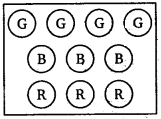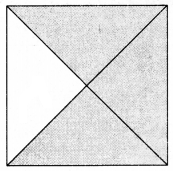Ncert Maths Class 7 Solutions Comparing Quantities
CBSE students can refer to NCERT Solutions for Class 7 Maths Chapter 8 Comparing Quantities InText Questions and Answers are provided by experts in order to help students secure good marks in exams.
Class 7 Maths NCERT Solutions Chapter 8 Comparing Quantities InText Questions
Try These (Page 158)
Question 1.
Rina made a tabletop of 100 different colored tiles. She counted yellow, green, red, and blue tiles separately and filled the table below. Can you help her complete the table?

Solution:
The complete table is shown below :

Try These (Page 158)
Question 1.
Find the percentage of children of different heights for the following data:

Solution:
The complete table is shown below :

Question 2.
A shop has the following number of shoe pairs of different sizes: Size 2: 20 Size 3: 30 Size 4: 28 Size 5: 14 Size 6: 8 Write this information in tabular form as done earlier and find the percentage of each shoe size available in the shop.
Solution:
Writing the data in the tabular form :

Try These (Page 159 – 160)
Question 1.
A collection of 10 chips with different colors is given :


Fill the table and find the percentage of chips in each color.
Solution:
The required percentage of chips of each color is as under :

Question 2.
Mala has a collection of bangles. She has 20 gold bangles and 10 silver bangles. What is the percentage of bangles of each type? Can you put it in the tabular form as done in the above example?
Solution:
Putting the data in the tabular form :

Try These (Page 161)
Question 1.
Convert the following to per cents :
(i)
Solution:
![]()
(ii) 3.5
Solution:
![]()
(iii)
Solution:
![]()
(iv)
Solution:
![]()
(v) 0.05
Solution:
![]()
Question 2.
(i) Out of 32 students, 8 are absent. What percent of the students are absent?
Solution:
Total number of students = 32
Number of absent students = 8
Percentage of absent students = % = 25%
(ii) There are 25 radios, 16 of them are out of order. What per cent of radios are out of order?
Solution:
Total number of radios =25
Number of out of order radios = 16
Percentage of out of order radios = % = 64%
(iii) A shop has 500 parts, out of which 5 are defective. What per cent are defective?
Solution:
Number of total parts = 500
Number of defective parts = 5
Percentage of defective parts = % = 1%
(iv) There are 120 voters, 90 of them voted yes. What per cent voted yes?
Solution:
Total number of voters = 120
Number of voters who voted yes = 90
Percentage of voters voted yes = % = 75%
Try These (Page 161 – 162)
Question 1.
Look at the table, observe and complete it:

Make some more such examples and solve them.
Solution:
The complete table is shown below :

Some more such examples with' solutions are as under :

Try These (Page 162)
Question 1.
(i) 35%+ ________ % = 100%
Solution:
35% + 65% =100% [∵ 100 – 35 = 65]
(ii) 64% + 20% + ________ % = 100%
Solution:
64% + 20% + 16% = 100% [∵ 64 + 20 = 84 and 100 – 84 = 16]
(iii) 45% = 100% – ________ %
Solution:
45% = 100% – 55% [∵ 100 – 45 = 55]
(iv) 70% = ________ % – 30%
Solution:
70% = 100% – 30% [∵ 70 + 30 = 100]
Question 2.
If 65% of students in a class have a bicycle, what percent of the student do not have bicycles?
Solution:
Percentage of students having cycle = 65%
Percentage of students having no cycle = (100 – 65)% = 35%
Question 3.
We have a basket full of apples, oranges, and mangoes. If 50% are apples, 30% are oranges, then what percent are mangoes?
Solution:
Percentage of apples in the basket = 50%
Percentage of oranges in the basket = 30%
Percentage of mangoes in the basket = (100 – 50 – 30)% = 20%
Try These (Page 163)
Question 1.
What percent of these figures are shaded?
You can make some more figures yourself and ask your friends to estimate the shaded parts.
(i)

Solution:
Sum of the shaded parts of the figure = +
+
=
=
Percentage of the shaded part = % = 75 %
(ii)

Sum of shaded parts of the figures = +
+
=
=
=
percentage of the shaded part = % = 50%
Try These (Page 164)
Question 1.
(i) 50% of 164
Solution:
50% of 164 = × 164 =
× 164 = 82
(ii) 75% of 12
Solution:
75% of 12 = × 12 =
× 12 =
×12 = 3 × 3 = 9
(iii) % of 64
Solution:
% of 64 =
× 64 =
×
× 64 =
x
× 64 = 8
Question 2.
8% of children of a class of 25 like getting wet in the rain. How many children like getting wet in the rain?
Solution:
Out of 100, 8 children like getting wet in rains. Therefore, out of 25, the number of children that like getting wet in rains
![]()
Try These (Page 164)
Question 1.
9 is 25% of what number?
Solution:
Let the number be a. then
25% of a = 9
⇒ × a = 9
⇒ × a = 9
⇒ a = 9 × 4
⇒ a = 36
∴ The required number is 36.
Question 2.
75% of what number is 15?
Solution:
Let the number be a. Then,
75% of a = 15
⇒ × a = 15
⇒ × a = 15
⇒ a × 15 ×
⇒ a = 5 × 4 = 20
∴ The required number is 20.
Try These (Page 166)
Question 1.
Divide 15 sweets between Manu and Sonu so that they get 20% and 80% of them respectively.
Solution:
Total number of sweets = 15
Number of sweets with Manu = 20% of 15
= = 3
Number of sweets with Sonu = 80% of 15
= 12
Question 2.
If the angles of a triangle are in the ratio 2:3:4, Find the value of each angle.
Solution:
Sum of the ratios = 2 + 3 + 4 = 9
Some of the angles of a triangle = 180°
∴ The angles are ,i.e., 40°;
, i.e., 60°; and
,i.e., 80°.
Hence, the measure of all the angles of a triangle is 40°, 60°, and 80°.
Try These (Page 167)
Question 1.
Find the percentage of increase or decrease :
—Price of the shirt decreased from? 80 to ₹ 60.
—Marks in a test increased from 20 to 30.
Solution:
(i) Original price of shirt = ₹ 80
The new price of the shirt = ₹ 60
Change in price = ₹ (80 – 60) = ₹ 20
Therefore, the percentage of decrease
= × 100
= × 100 = 25%
(ii) Original marks = 20
New marks = 30
Change in marks = (30 – 20) = 10
Therefore, the percentage of increase
× 100
× 100 = 50%
Question 2.
My mother says, in her childhood petrol was? 1 a liter. It is? 52 per liter today. By what percentage has the price gone up?
Solution:
Original price of petrol = ₹ 1
New price of petrol = ₹ 52
Change in price = ₹ (52 – 1) = ₹ 51
Therefore, the percentage of increase
× 100
× 100 = 5100%
Try These (Page 169)
Question 1.
A shopkeeper bought a chair for ₹ 375 and sold it for ₹ 400. Find the gain percent.
Solution:
We have,
C.P. of the chair = ₹ 375
S.P. of the chair = ₹ 400
Since, S.P. > C.P. so, the gain is given by
Gain = S.P. – C.P.
= ₹ (400 – 375) = ₹ 25
Now, Gain % =
= =
=
Question 2.
The cost of an item is ₹ 50. It was sold with a profit of 12%. Find the selling price.
Solution:
We have, C.P. = ₹ 50 and profit = 12%
∴ Profit = 12% of ₹ 50 = ₹ = ₹ 6
S.P. = ₹ (50 + 6) = ₹ 56
Question 3.
An article was sold for? 250with a profit of 5%. What was its cost price?
Solution:
We have, S.P. = ₹ 250 and profit = 5%
c.p. =
= ₹ = ₹
= ₹ = ₹
Question 4.
An item was sold for ₹ 540 at a loss of 5%. What was its cost price?
Solution:
We have, s.p. = ₹ 540 and loss = 5%
c.p. = = ₹
= ₹
= ₹
= ₹ 568
Try These (Page 170)
Question 1.
₹ 10,000 is invested at a 5% interest rate p.a. Find the interest at the end of one year.
Solution:
We have, P = Principal = ₹ 10,000, R=Rate per cent per annum = 5 and, T = Time = 1 year.
∴ Simple interest (S.I.) =
= ₹
= ₹ 500
Question 2.
₹ 3,500 is given at a 7% p.a. rate of interest. Find the interest which will be received at the end of two years.
Solution:
We have, P = Principal = ₹ 3500 R = Rate per cent per annum = 7 and, T = Time = 2 years
∴ Simple interest (S.I.) =
= ₹
= ₹ 490
Question 3.
₹ 6,050 is borrowed at a 6.5% rate of interest p.a. Find the interest and the amount to be paid at the end of 3 years.
Solution:
We have, P = Principal = ₹ 6050, R = rate of interest per annum = 6.5 and, T = Time = 3 years
∴ Simple interest (S.I.) =
= ₹ = ₹ 1179.75
Now, Amount = Principal + S.I.
= ₹ (6050 + 1179.75)
= ₹ 7229.75
Question 4.
₹ 7,000 is borrowed at 3.5%.rate of interest p.a. borrowed for 2 years. Find the amount to be paid at the end of the second year.
Solution:
We have, P = Principal = 17000, R = rate per cent per annum = 3.5 and, T = Time = 2 years.
∴ Simple interest (S.I.) =
= ₹ = ₹ 490
Now, Amount = Principal + S.I.
= ₹ (7000 + 490) = ₹ 7490
Try These (Page 171)
Question 1.
You have ₹ 2,400 in your account and the interest rate is 5%. After how many years would you earn? 240 as interest?
Solution:
We have, P = ₹ 2400, R = 5% p.a. and S.I. = ₹ 240, Time = ?
∴ Time =
⇒ Time = years = 2 years
Question 2.
On a certain sum, the interest paid after 3 years is ₹ 450 at a 5% rate of interest per annum. Find the sum.
Solution:
We have , S.I. = ₹ 450, R = 5% p.a., T = 3 years, proncipal = ?
∴ Principal =
⇒ Principal = ₹ = ₹ 3000
Ncert Maths Class 7 Solutions Comparing Quantities
Source: https://www.cbsetuts.com/ncert-solutions-for-class-7-maths-chapter-8-intext-questions/
0 Response to "Ncert Maths Class 7 Solutions Comparing Quantities"
Post a Comment